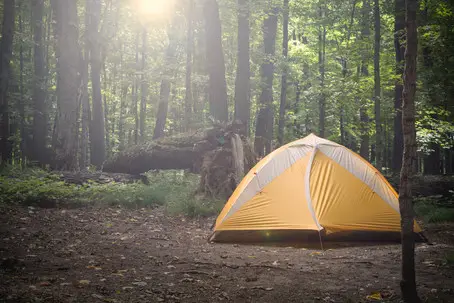
There’s nothing quite like waking up to the sound of birds tweeting, sipping a fresh cup of coffee as you take in the morning views, or sharing a bottle of wine or a flask of something hot around a campfire at night. In this post-isolation world, escaping the city and getting back to nature is an incredibly important experience.
Spending a night (or several if you’re lucky) outdoors camping can take your hiking trip to the next level.
But to ensure it turns out just as idyllic as the picture I painted, you need to know the tricks of the trade. Here’s my camping for beginners guide to choosing the best campsite spot to make sure your trip is as dreamy as you imagine it.
Pick Your Spot With Plenty of Time
It’s easy to get carried away and want to keep walking until sunset, but if you’re planning on pitching up for the night – this is a big no-no. Plan your route before you set off and make sure to call it a day at least two hours before the sun starts to set. Not only does this give you time to put up your tent in daylight, but it also allows you plenty of time to choose the ideal campground.
The Perfect Ground Conditions
First things first, you need to consider your base. Find even ground. Even a slight slope may leave you waking up in the middle of the night crumpled in a heap at the lower end of the tent. Make sure to avoid camping at the bottom of a slope, especially if there’s a rain forecast which will lead to you floating in a newly formed lake.
Test the ground before you set up camp, feel to see if there is even a slight hint of moisture and if there is, keep searching. You’ll be grateful for your diligence when you wake up to nice, dry clothes.
Double-Check Your Position
Something that often divides experienced campers is shade. Many will tell you to always choose a spot in the shade, which I agree, in summer is ideal. However, winter camping is a totally different matter. Those colder morning temperatures call for some much-needed dawn rays, partly to warm you up and also to wake you up. It’s much harder to get out of a cozy sleeping bag when you don’t have the sunshine tempting you to venture out of your tent. Another winter camping tip is to choose a campsite on higher ground, as colder air collects in valleys. So if you want to keep warm, choose a site with a higher elevation.
Also, be sure to avoid parking up under any big trees. No matter how strong they look, a falling branch is just a strong gust of wind away. To avoid any nighttime disturbances, try to stick to open spaces, away from any trees, cliffs, and loose rock formations.
Do Your Research
To avoid any of the above-mentioned situations, do your research before you go. Use the NSW Parks and Wildlife official websites or you can look up blogs and articles to see the recommendations of previous visitors to the area. Forward planning can also clinch you a location close to a water source, essential for any overnight camping spot, or be prepared to sanitise the water you collect.
Knowing where you are going to spend the night before you go can reduce stressful, last-minute scrambles for a suitable spot and make the day’s hike even more enjoyable!
Be Respectful
When choosing your ideal campsite, remember that you’re not the only happy campers on the trail. Remember not to infringe on others’ secluded spots, the idea of wild camping is to get away from other people, so be careful to respect that.
But it’s not just humans that you need to respect, after all, it’s not their home you’re a guest in. Remember at all times to leave no trace. If you have a choice between an idyllic, untouched field and a slightly worn-down patch of grass, go for the latter and preserve what is still intact. Research the rules about campfires before you head out into a park or onto a trail, and if you need a permit, get one! If you are allowed to make a campfire, make sure not to damage any of your surroundings, and don’t leave your spot until you’re 100% certain it’s out. It should go without saying but take all your rubbish home with you. Leave your campsite as you found it so its inhabitants can happily continue with their life!